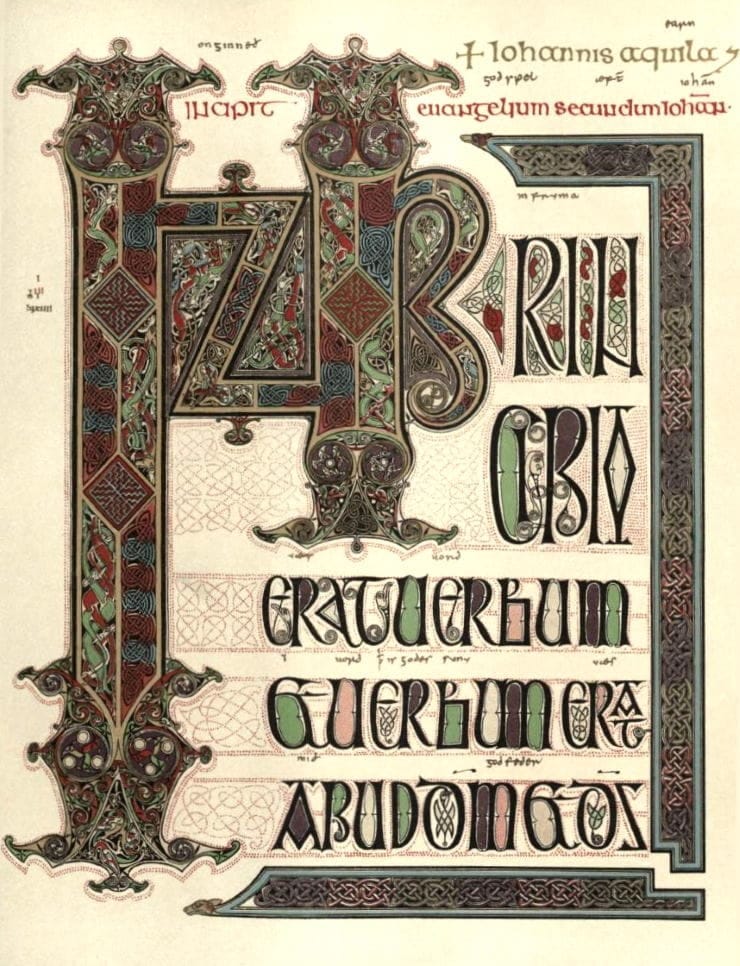Imagine sitting at home peacefully reading and writing with some friends when suddenly a group of large, armored people burst in, slaughter some of your friends, raid your fridge, and steal your valuables. No, this isn’t a Republican attack ad attempting to promote the idea that scary things will happen if you vote Democrat. Instead, it’s a brief description of what happened at Holy Island, known as Lindisfarne, when Vikings burst onto the world stage on this date, 8 June 793.
Lindisfarne is an island off the Northumbrian coast in England, about sixty miles from Newcastle in the northeast. The Irish monk Aidan, at the request of King Oswald of Northumbria, founded a Christian abbey and monastery on the island in 634 or 635. There the monks attended to their prayers, grew their food, spread the gospel to the local (relatively speaking) communities of Anglo-Saxons, and created the Lindisfarne Gospels.
Lindisfarne Gospels
The Lindisfarne Gospels are illustrated manuscripts – books with artistic flourishes and illustrations – written around 715 as a Latin copy of the Gospels of Matthew, Mark, Luke and John. They are considered some of the finest works of Insular art, which combines Mediterranean, Anglo-Saxon, and Celtic elements throughout the art and writing. The Gospels were probably produced to honor the former abbot Cuthbert, who died in 687 and was buried on the island. Cuthbert was later canonized at St. Cuthbert, in part because when his sarcophagus was opened eleven years after his death, his body was found to have been perfectly preserved. This led to a growing Cuthbert cult around Northumbria, with Lindisfarne serving as a pilgrimage site. Thus, the island was a Christian spiritual center in the late 8th century.
Europe and the Viking Age
This was the same time as Charlemagne was consolidating his own power in Central Europe, largely consisting of fighting against non-Christians to force them to accept Christianity, on his way to becoming the first Holy Roman Emperor.
Some of those people who Charlemagne, and other newly devout rulers, fought were the Norsemen, or Vikings, in Scandinavia (Denmark, Sweden, and Norway). A notable seafaring people, the Vikings began expansion from their homelands around that same time, possibly because of forced conversions, possibly due to overpopulation and the need for farmland, possibly due to the desire for riches, or possibly for some unknown reasons. Scholars still debate the reasons.
When the Vikings raided Lindisfarne in 793 it began the “Viking Age.” Over the next more than 250 years, Vikings dominated and influenced European life, culture, and politics, which still have echoes down to today (such as in Thor the Avenger from Marvel comics and film fame).
During those centuries, the Vikings raided Lindisfarne again in 875, when the monks fled to Durham with Cuthbert’s bones and a copy of the famous Gospels. The bones still reside in Durham, while the Gospels eventually came into the possession of Sir Robert Cotton who, after his death, left his collection to the British Museum. The Vikings also settled in the Orkney islands, York, and Dublin (among other places in the British Isles), founded Iceland and Kiev (later known as the Kievan Rus’), and served as personal guards for the Byzantine Emperor, where they were called the Varangian Guard. They sailed to North America, where they became the first Europeans to set foot in Newfoundland. They had extensive trade routes all across Europe. And, of course, they settled in Normandy, named after one of the terms they were given, “Northmen.” It was under the Norman leader William the Conqueror that invaded England in 1066, which forever changed life in Britain, and effectively ending the “Viking Age.” What began with one invasion of a minor island ended with another island almost 300 years later.






